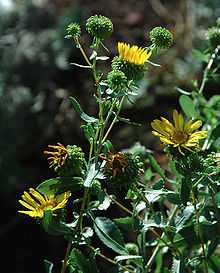Grindelia squarrosa
| Grindelia squarrosa | |
|---|---|
 | |
| Curlycup gumweed (Grindelia squarrosa) | |
| Scientific classification | |
| Kingdom: | Plantae |
| (unranked): | Angiosperms |
| (unranked): | Eudicots |
| (unranked): | Asterids |
| Order: | Asterales |
| Family: | Asteraceae |
| Tribe: | Astereae |
| Genus: | Grindelia |
| Species: | G. squarrosa |
| Binomial name | |
| Grindelia squarrosa | |
| Wikispecies has information related to: Grindelia squarrosa |
| Wikimedia Commons has media related to Grindelia squarrosa. |

Grindelia squarrosa, also known as a curly-top gumweed or curlycup gumweed, is a small North American biennial or short-lived perennial plant. [1]
It is native to western and southwestern North America, including the Great Plains and Rocky Mountains regions. [2] It is often found in isturbed roadsides, streamsides; 700–2,300 metres (2,300–7,500 ft) in elevation.
It is an introduced species in California, the Pacific Northwest, and the Mid-Atlantic Eastern Seaboard. [3] [4]
Description
Grindelia squarrosa is a decumbent to erect, much-branched plant. It grows to a maximum height of 90 cm (appx. 3 ft). The 1.5–7 cm leaves are gray-green in color, crenate with each tooth having a yellow bump near its tip, and resinous. [3]
It bears Asteraceae family type ray flowers, with 24–36 yellow petals, and is 8–10 mm in diameter. It blooms from July through late September. [3] [5]
Varieties
- Grindelia squarrosa var. quasiperennis [6]
- Grindelia squarrosa var. serrulata [7]
- Grindelia squarrosa var. squarrosa [8]
Uses
Grindelia squarrosa is a notable native pollinators plant in its natural habitats, listed by the Lady Bird Johnson Wildflower Center Native Plant Information Network—NPIN to be of "Special Value to Native Bees."[4]
The plant concentrates selenium, and can be toxic when ingested by cattle, humans, and other mammals. [3]
Native American medicinal plant
Grindelia squarrosa was used by Great Plains Tribes as a medicinal herb to treat illnesses such as asthma, bronchitis or skin rashes. [9] [4] [10]
It was used as a traditional medicinal plant by Shoshone peoples in various regions.[9] The Gosiute band dialect's Shoshone language name for the plant is mu’-ha-kûm. [11] The Lakota language name for the plant is pteíčhiyuȟa.
See also
- Pollinator decline
- Plants and pollinators
References
- ↑ ITIS Standard Report Page: Grindelia squarrosa
- ↑ USDA: Grindelia squarrosa
- ↑ 3.0 3.1 3.2 3.3 Jepson (TJM2)
- ↑ 4.0 4.1 4.2 Lady Bird Johnson Wildflower Center Native Plant Information Network—NPIN Database: Grindelia squarrosa (Curlycup gumweed)
- ↑ Kansas Wildflowers & Grasses
- ↑ USDA: Grindelia squarrosa var. quasiperennis
- ↑ USDA: Grindelia squarrosa var. serrulata
- ↑ [http://plants.usda.gov/core/profile?symbol=GRSQS2 USDA: Grindelia squarrosa var. squarrosa
- ↑ 9.0 9.1 University of Michigan at Dearborn, Native American Ethnobotany Database: Grindelia squarrosa
- ↑ Northern Prairie Wildlife Research Center
- ↑ Chamberlin, Ralph Vary (1911). "The Ethno-botany of the Gosiute Indians of Utah" (PDF). Memoirs of the American Anthropological Association Vol II, part 5. Retrieved 2007-11-12.
External links
- USDA Plants Profile for Grindelia squarrosa (curlycup gumweed)
- Calflora: Grindelia squarrosa — non-native to California, and naturalized in the wild.
- Jepson eFlora (TJM2) treatment of Grindelia squarrosa var. serrulata — introduced species, naturalized in California.